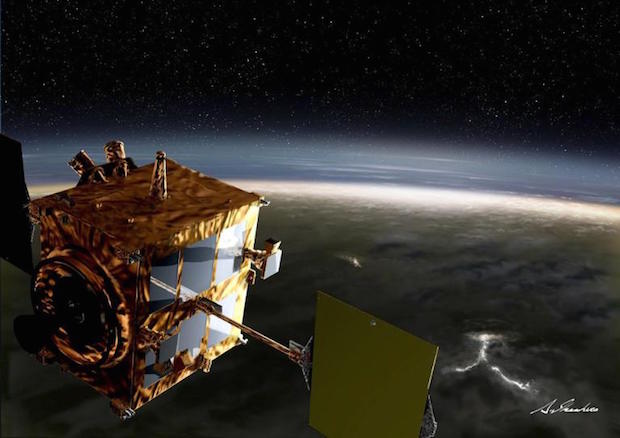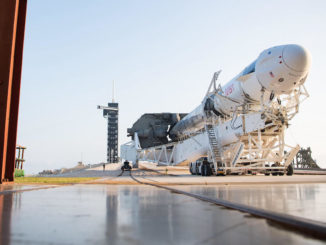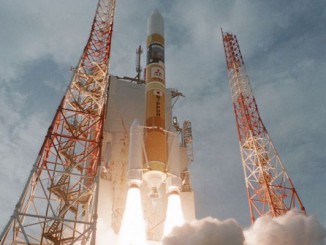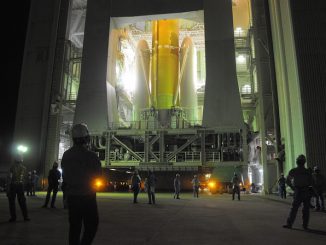
Inside a month until its next chance to swing into orbit around Venus, Japan’s Akatsuki spacecraft has weathered unexpectedly “severe” conditions after missing an arrival opportunity in 2010, according to the mission’s project scientist.
The space probe accomplished its last targeting maneuver Oct. 11 to aim for its Dec. 7 arrival at Venus, and all systems are go for the encounter, said Takeshi Imamura, Akatsuki’s project scientist at JAXA’s Institute of Space and Astronautical Science.
Imamura said the Akatsuki spacecraft, named for the Japanese word for dawn, will zoom 541 kilometers, or 336 miles, above Venus for a 20-minute insertion burn using the probe’s secondary attitude control thrusters. Japanese ground controllers have programmed the probe to use the backup rocket jets after a faulty valve knocked out Akatsuki’s main engine during its first attempt to enter orbit around Venus in December 2010.
Four of the eight attitude control thrusters aboard Akatsuki will fire for 20 minutes and 33 seconds to slow the spacecraft down enough for Venus’ gravity to pull it into an egg-shaped orbit that skims above the planet’s cloud tops on the low end and ranges several hundred thousand miles in altitude at peak altitude.
The reaction control thrusters, originally designed to help point the spacecraft, were not rated for such a hefty propulsive maneuver.
“In the original plan, we used these RCS (thrusters) only for attitude control — mostly using these thrusters only for unloading angular momentum — so we did not expect such a long (burn),” Imamura said last month in a presentation to NASA’s Venus Exploration Analysis Group. “So yes … this kind of operation is rather dangerous, but in the previous (burns) already conducted, we have already tested 10 minutes of propulsion, so 20 minutes is not very long compared to the (maneuvers) we have already conducted.”
Akatsuki’s main engine, designed for 112 pounds of thrust, is unavailable after a failed burn during the mission’s first encounter with Venus five years ago. The engine cut off less than three minutes into a 12 minute burn, providing an insufficient impulse for the craft to be captured in orbit.
Engineers believe a salt formation in a check valve inside the spacecraft’s propulsion system restricted the flow of fuel to the main engine, starving it of fuel and creating an oxidizer-rich combustion condition, raising temperatures inside the engine before it failed.
The probe continued on in an orbit around the sun following the failed insertion maneuver in 2010, and ground controllers searched for a new way to steer Akatsuki into Venus’ orbit during its next flyby of the planet in 2015.
The ground team commanded Akatsuki to dump 65 kilograms, or 143 pounds, of unnecessary propellant to lighten the spacecraft, making it easier to maneuver with the secondary propulsion system, which does not require an oxidizer for its firings.
A series of course correction burns using the attitude control thrusters over the last five years has put Akatsuki on track for its Dec. 7 arrival opportunity. The maneuvers also demonstrated long duration burns, giving officials some confidence ahead of the make-or-break firing at Venus.
Akatsuki blasted off in May 2010 aboard a Japanese H-2A rocket, and the original flight plan called for a six-month cruise to Venus.
During its unexpected five-year sojourn, the probe passed closer to the sun than Akatsuki’s designers intended, spending months inside the orbit of Venus. The orbit forced the spacecraft to weather extreme temperatures that some officials worried would threaten the mission.
“The temperature condition was quite severe, especially when we passed through perihelion,” Imamura said. “We experienced unusually high temperatures repeatedly because of the short distance between the sun and Akatsuki at perihelion. The solar input was 37 perent larger than the nominal condition.”
The craft survived its last perihelion passage in August, and temperatures are now falling as it approaches Venus on the outbound leg of its orbit.
Akatsuki completed its last burn before getting to Venus in October, and tracking data supplied by NASA’s Deep Space Network show the probe is right on track for Venus.
While acknowledging the Dec. 7 maneuver is risky, Imamura said “we do not think of this operation as very dangerous.”
The smaller thrusters aboard Akatsuki generate just 5 pounds of thrust, a fraction of the power provided by the probe’s main engine. Even with four of the rocket jets operating — there are two sets of four pointing forward and aft from Akatwuki’s main body — the secondary thrusters do not have the energy to put the spacecraft into its originally planned orbit.
Instead, Akatsuki will go into a higher orbit than intended, and the change has some impact to the craft’s science mission, Imamura said.
Rather than taking about 30 hours to complete a lap around Venus — as was planned after the botched 2010 arrival — Akatsuki will complete one orbit every 15 days. Another maneuver in March will nudge Akatsuki closer to Venus, placing the probe in a nine-day orbit.
Imamura said three of Akatsuki’s five cameras were recently switched on for the first time in more than four years, and they appeared to be in good health. The other two cameras will be activated once the probe is in orbit at Venus.
Engineers plan to instruct Akatsuki to turn its cameras toward Venus immediately after the insertion burn in a bid to collect “contingency” imagery of the planet in case the maneuver fails.

Scientists used the cameras to peer back at Venus from a distance of 600,000 kilometers — about 372,000 miles — after it missed the planet in 2010, revealing a thin sunlit crescent in infrared and ultraviolet.
Even if the upcoming bid to enter Venus’ orbit comes up short, scientists say Akatsuki will get a much closer look at the planet than possible in 2010.
If the arrival is successful, Akatsuki will become the only spacecraft currently operating at Venus. The European Space Agency’s Venus Express probe ended its mission there in late 2014.
Imamura said Japanese scientists have planned observations at Venus for at least two years after Akatsuki’s arrival.
“The orbit around Venus in the new plan will be a very long elliptical one,” Imamura said. “From far distances, we continually monitor the global-scale dynamics of the atmosphere and clouds, and of course, from close distances, we take close-up images of the atmosphere, the surface, and we also observe lightning and airglow when the spacecraft is in the shadow of Venus.”
Also named the Venus Climate Orbiter, Akatsuki is primarily designed to study the Venusian atmosphere.
The mission will observe climate and weather conditions on Venus with a suite of five cameras to look at low-altitude cloud patterns, chart the distribution of water vapor and carbon monoxide, and map the surface of Venus with a goal of finding active volcanoes. Thick clouds prevent visible cameras from seeing through Venus’ global clouds, but scientists say an infrared imager aboard Akatsuki can resolve the surface.
A long-wavelength infrared camera and an ultraviolet instrument aboard Akatsuki will study the super-rotating cloud structures in the upper atmosphere. The ultraviolet camera will also track sulfur dioxide, a precursor to cloud formation at Venus.
Researchers also plan to measure radio waves transmitted through the planet’s atmosphere to measure its profile.
Imamura said engineers have uploaded new software to Akatsuki to better see Venus from the spacecraft’s higher-than-planned orbit, reducing the data volume coming back to Earth to streamline the mission’s scientific return.
“By combining this information, we can model the three-dimensional structure of the atmosphere and the clouds,” Imamura said.
Email the author.
Follow Stephen Clark on Twitter: @StephenClark1.



